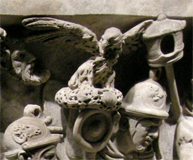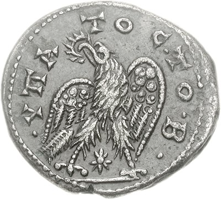
This page created 29 March 2014, and last modified: 3 October 2015 (Vegetius reference and commentary added)

In the eastern half of the empire, the second-most senior unit of the legiones palatina under the command of the first Master of the Soldiers in the Imperial Presence (i.e. the Magister Militum Praesentalis I) is listed as the Ioviani iuniores (9.18 in Ingo Maier's numbering scheme). Its shield pattern (7#3) as shown in various manuscripts, under the matching label (7.c) Ioviani iuniores, is as below:

The pattern has an indigo outer rim (purple in B, faded to maroon in W, light blue in M), a blue inner rim (absent in W, red in M), and a red band inside that (yellow in M, more orange in W). The main ground is yellow, on which is featured an heraldically displayed (and in O and P, apparently haloed; see below) eagle in purple (maroon in M, blue in W); the shield's boss is yellow (blue in W, and with a yellow rim in M). This pattern is one of a set of four very similar patterns, belonging to the Ioviani seniores (98/9.21), the Herculiani seniores (98/9.22), the Ioviani iuniores, and the Herculiani iuniores (9.19), with the two paired iuniores units being in the east, under the command of the first Master of the Soldiers in the Imperial Presence, and the two paired seniores units in the west, under the Magister Peditum in his Italian command. The patterns shown below taken from the Paris manuscript clearly show this relationship:

Despite their close similarities, nonetheless, there are differences. The pattern of the Ioviani iuniores alone, for example, shows the eagle surmounted by what might be taken for a halo but is probably better regarded as a wreath (see below). Therefore, like that of the Herculiani iuniores, this eagle would appear to be represent not the image of a living bird, but that of a legionary standard.

|

|

|
|
Aquila of Legio III Cyrenaica, as depicted on a denarius of Marcus Antonius struck in 32 BC. Picture from http://www.cngcoins.com under CCA 3.0 license. |
Aquila of Legio IIII Flavia from the Portonaccio Sarcophagus of ca. 190 AD. Picture from National Museium of Rome under CCA 3.0 license. |
Aquila of Legio I Minerva, from Trajan's column. Picture from National Museium of Rome under CCA 3.0 license. |
Aquilae (legionary eagle standards) seemed to have taken a variety of forms as can be seen from the above representations. Alas, no legionary aquila has survived to the present day, although a non-legionary Roman eagle has been recovered from Silchester in Britain, minus its wings. The shield pattern's "halo" would appear to be not a halo behind the eagle's head, but rather a wreath held in its beak; this type imagery is found on various Roman coins, as shown below:

|

|

|
|
Roman provincial tetradrachm from Laodicea (Syria) minted 208/9 AD. Obverse: Bust of Geta. Picture from http://www.cngcoins.com under CCA 3.0 license. |
Roman provincial tetradrachm from Antiochia (Syria) minted ca. 216 AD. Obverse: Bust of Caracalla. Picture from http://www.cngcoins.com under CCA 3.0 license. |
Roman provincial tetradrachm from Alexandria (Egypt) minted ca. 230 AD. Obverse: Bust of Severus Alexander. Picture from http://www.cngcoins.com under CCA 3.0 license. |
The original Ioviani legion was a Tetrarchic creation of the last quarter of the 3rd century; Ioviani refers not only to the god Jupiter, but also the senior emperor, Diocletian, in much the same way Herculiani refers to not only Hercules, but the other Augustus in the Tetrarchic system, Maximian. Interestingly, the Arch of Galerius (another of the Tetrarchs, and who was identified with Mars), shows two shield patterns that apparently belong to the original Ioviani and Herculiani units: one shows an image of Hercules (readily identifiable by his club and lion skin); the other, depicted below, shows an eagle.

This eagle is much smaller in proportion to the size of the shield than those born by the Ioviani units shown in the Notitia, being somewjat closer in scale to those borne in the Notitia by e.g. the Quartodecimani (18.17) under the Magister Militum per Thracias. The eagle is an attribute (i.e. symbol) of Jupiter (Iovius), and thus might reasonably appear on a shield bearing the name Ioviani as an actual bird as opposed to a unit standard - but it is not clear to me whether this eagle is intending to represent a living bird or an inanimate statue - the thing it is perched on could well be a lightning bolt (another attribute of Jupiter's).
Clearly by the time of the Notitia, this exact shield pattern was no longer in use. One possible point at which it could have been superseded would have been when the unit was split into seniores and iuniores; however, any time is possible after Constantine I's public espousal of Christianity (and by implication, if not actual practice) the disavowal of Hercules. When the "original" Ioviani and Herculiani legions were split into seniores and iuniores units is unknown, other than being likely mid-4th century. Vegetius states (1.17) that the original Ioviani was already in existence when Diocletian became emperor, although this statement is often discounted; it being assumed "the" Ioviani would have been raised during his reign (perhaps as one of legiones I, IV, or V Iovia; Seeck certainly saw them as coming from legio I Iovia). However, one should be alive to the possibility that any unit formed by the Romans might have been a more of a rebranding exercise involving one or more former units than enrolling a new body of men. The increase in the number of legions during the Tetrarchy could, for example, have been accomplished by converting auxiliary units into legionary formations as much as by new recruitment.
Possible inscriptional evidence for the Ioviani iuniores comes from the cemetery at Colonia Iulia Concordia (modern Portogruaro in Veneto, Italy), which produced an inscription (ILS 551) mentioning a soldier EX N MILIT IOVIANORUM, which clearly means "ex numero militum Iovianorum. Although the Ioviani iuniores presumably spent time in the vicinity of Concordia in the years 394 and 395 in the struggle between Eugenius and Theodosius I, the inscription is more likely, however, to relate to the Ioviani seniores, since it was this unit that was normally stationed in the region. See here for Hoffmann's 1963 analysis (in German).

Return to the Notitia alphabetical unit list page.
Return to my Notitia index page.